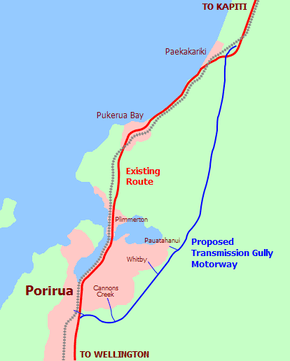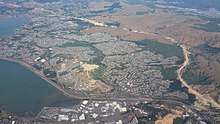Transmission Gully Motorway
The Transmission Gully Motorway is a 27-kilometre (17 mi) four-lane motorway under construction north of Wellington, New Zealand.[1] Construction officially began on 8 September 2014 and completion was originally scheduled for April 2020, but contractural negotiations as well as difficulties resulting from the COVID-19 pandemic have resulted in delays, with the opening now no earlier than late 2021, and possibly as late as 2023.[2][3]
| |
|---|---|
| State Highway 1 | |
 The route of the Transmission Gully Motorway. The map does not reflect the actual location of the link roads. | |
| Route information | |
| Maintained by NZ Transport Agency | |
| Length | 27 km (17 mi) |
| Status | under construction |
| Major junctions | |
| North end | |
| South end | |
| Location | |
| Primary destinations |
|
| Highway system | |
Route
It will complement the current State Highway 1 along the coast road between the Kapiti Coast, Pukerua Bay and Porirua. From SH1 at MacKays Crossing, north of Paekakariki, the route rises steeply to the Wainui Saddle and follows Transmission Gully down to Porirua Harbour's Pauatahanui Inlet. It continues south around the outer edge of the Porirua urban area, at one point crossing a 300-metre-long and 90-metre-high bridge, and rejoins SH 1 at the boundary of Porirua and Tawa. The length is 27 km, with a maximum gradient of about 8.3%.
Three intermediate interchanges are included in the project. The first interchange is with State Highway 58 at Pauatahanui, providing access to the Hutt Valley. The second interchange will link via new local roads to James Cook Drive in Whitby and the Warspite Avenue-Niagara Street intersection in Waitangirua. The third interchange will link via a new local road to Kenepuru Drive south of the Porirua city centre."
Construction

Proposals have existed for some time, but it was only late in the first decade of the 21st century that serious steps were taken towards construction. The Greater Wellington Regional Council, in preparing its Western Corridor Plan, initially rejected Transmission Gully as unaffordable, preferring to upgrade the existing coastal route, but changed its position after public consultation.
On 15 December 2009 Minister of Transport Steven Joyce announced the Government's commitment to the project as one of seven Roads of National Significance, with a predicted project cost of NZ$1.025 billion.[4]
On 15 August 2011, the New Zealand Transport Agency (NZTA), Porirua City Council, and Transpower New Zealand Limited jointly applied to the Environmental Protection Authority (New Zealand) (EPA) for notices of requirement and resource consents for the Transmission Gully Proposal.[5]
On 4 May 2012, after a series of public hearings, the EPA-appointed board of inquiry into the Transmission Gully proposal stated in a draft decision that it would grant resource consents for the project.[6]
On 22 June 2012, the Environmental Protection Authority released the Transmission Gully Board of Inquiry's final report.[7] The Board of Inquiry approved the resource consents and the notices of requirement required for the Transmission Gully Proposal.[8]
On 16 May 2013, national grid owner Transpower applied for consent to the Kapiti Coast District Council to rebuild its Valley Road, Paraparaumu substation to 220 kV and build two short transmission lines to connect it to the two Bunnythorpe to Haywards 220 kV lines to the east. This would allow Transpower to demolish the existing 110 kV line between Pauatahanui and Paraparaumu through Transmission Gully, rather than having to relocate it around the motorway.[9][10]
In spite of significant opposition, construction of the four-lane motorway began on 8 September 2014 with completion originally scheduled by Christmas 2020.[11][12]
Controversy
Developing the Transmission Gully Motorway was controversial, and was a topic of considerable debate in Wellington politics for some time. The route north of Wellington known as the Centennial Highway from Ngauranga to Pukerua Bay and Paekakariki had been started in 1936 and was opened on 4 November 1939; the section north from Pukerua Bay is along the coast and below the Paekakariki escarpment.[13] [14]
Supporters claimed that it will improve access to Wellington City, arguing that the existing coastal route is too congested, is accident-prone, and could be damaged in a serious earthquake. Peter Dunne, MP for Ohariu, says that "[i]mproving Wellington City's northern access and egress is a vital key to the future economic performance and prosperity of the whole region, and the Transmission Gully highway is a vital link in that chain".[15]
Opponents of Transmission Gully stated that there were better ways to improve access to Wellington. The highway would require an extremely steep gradient on its northernmost end and many opponents consider that it would thus not actually offer any improvement over the existing coastal highway. The route that the highway must take is along the major fault line of the region, which would make it at least as earthquake prone as the existing coastal highway.
Some suggested that the existing coastal route should be upgraded, rather than building a completely new route. This was the original recommendation of the Regional Council, and was put forward as the primary alternative to building Transmission Gully. Public submissions to the Council were in favour of Transmission Gully, and the Council has changed its stance in response.
Opponents of upgrading the coastal route said that doing so would cause significant disruption to the communities it passes through, whereas Transmission Gully avoids urban areas. The former Mayor of Porirua, Jenny Brash, has said that an upgrade would generate large numbers of complaints from Porirua residents, and would therefore have difficulty receiving resource consent.[16] Others, such as the Green Party and the lobby group Option 3, believed that the money would be better spent on improving Wellington's public transport, particularly the existing rail line. They argued that the original choice between building Transmission Gully or upgrading the coastal route was a false dichotomy, and that in reality neither option was necessary or desirable.
Cost
Some opponents of the Transmission Gully project believed that its overall cost is too high, and that the region has insufficient funds to spend on it, with a benefit/cost ratio of 0.6. The previous Mayor of Wellington, Kerry Prendergast, has described the project as "unaffordable".[17] It has been suggested that making Transmission Gully a toll road would help resolve this problem and tolls would only cover a fraction of the funds necessary to build the highway.
In May 2012, Julie Anne Genter, the Greens' spokeswoman on transport, described the motorway as incurring costs of $1 billion when the official business case benefits were $600 million, in order to ease congestion for an unlikely projected growth of 1500 vehicles per day.[18] In February 2020 it was announced that the expected cost of $850m had been increased by another $191m.[19]
Technical and environmental issues
There have been claims that the route of Transmission Gully is problematic due to steep gradients, environmental damage and earthquake hazards. The route passes near the Pauatahanui Inlet, an environmentally sensitive wetland area, and construction has been identified as the likely cause of increased sedimentation.[20]
Exit list
| Territorial authority | Location | km | Destination(s) | Notes |
|---|---|---|---|---|
| Kapiti Coast District | Mackays Crossing | SH 1 continues as Kapiti Expressway | ||
| Whareroa Road – Queen Elizabeth Park | 40.9709°S 174.9830°E | |||
| Paekakariki | Centennial Highway – Paekakariki | |||
| Porirua City | Pauatahanui | |||
| Whitby | James Cook Drive – Whitby, Waitangirua | |||
| Linden | Kenepuru Link Road – Porirua City Centre | |||
| SH 1 continues as Johnsonville-Porirua Motorway | ||||
1.000 mi = 1.609 km; 1.000 km = 0.621 mi
| ||||
References
- "Transmission Gully motorway". NZ Transport Agency. Retrieved 18 December 2017.
- George, Damian (11 October 2019). "Wellington Gateway Partnership suing NZTA for millions over delays to Transmission Gully". Stuff. Retrieved 1 January 2020.
- Maxwell, Joel (12 July 2020). "Transmission Gully opening could be pushed back to 2023 - Road Transport Forum boss". Dominion Post. Stuff. Retrieved 4 August 2020.
- Williamson, Kerry (15 December 2009). "Tolls to fund Transmission Gully route". The Dominion Post. Retrieved 15 December 2009.
- EPA (August 2011). "Transmission Gully Proposal". Environmental Protection Authority. Retrieved 25 June 2012.
- BusinessDesk (4 May 2012). "Inquiry Board gives draft approval for Transmission Gully". Scoop News. Retrieved 4 May 2012.
- The Board of Inquiry into the Transmission Gully Proposal (12 June 2012). "Final report and decision on the applications from the New Zealand Transport Agency (NZTA), Porirua City Council, and Transpower New Zealand Limited, for Notices of Requirement and Resource Consents for the Transmission Gully Proposal". Environmental Protection Authority. Retrieved 25 June 2012.
- "Transmission Gully Proposal approved" (Press release). Environmental Protection Authority. 22 June 2012. Retrieved 25 June 2012.
- Maxwell, Joel (26 February 2013). "Troubled power lines could go". The Dominion Post (via Stuff.co.nz). Retrieved 28 July 2013.
- "Notified Resource Consents and Notices of Requirement – Transpower NZ Ltd". Kapiti Coast District Council. Retrieved 28 July 2013.
- "Transmission Gully route to open by Christmas, with $1 billion price tag".
- The New Zealand Herald 8 September 2014
- "Paekakariki escarpment". Tracks.org. 14 May 2015.
- Reilly, Helen (2013). Pauatahanui: A local history. Wellington: Pauatahanui Residents Association. pp. 42, 128–9. ISBN 978-0-473-25439-1.
- Prendergast needs to move on (United Future press release)
- Porirua City Council submission on Transmission Gully
- Transmission Gully unaffordable – Wellington mayor (Dominion Post)
- Genter, Julie Anne (15 May 2012). "Transmission Gully Figures Don't Stack Up". Stuff. Retrieved 13 August 2012.
- "Wellington's Transmission Gully project blows out by extra $191m". RNZ. 14 February 2020. Retrieved 15 February 2020.
- "Roading project likely suffocating wildlife in Porirua Harbour - Survey". RNZ. 29 August 2019. Retrieved 21 December 2019.
